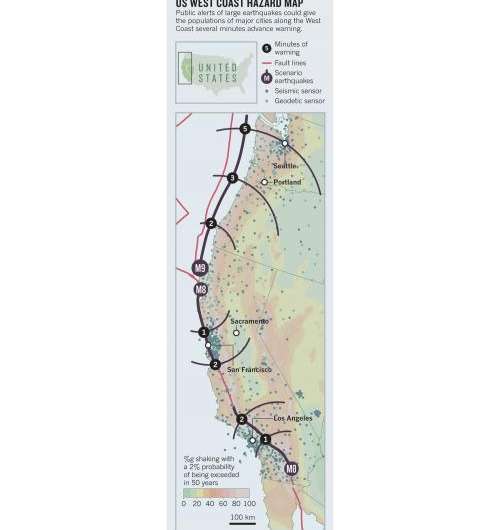October 3, 2013 report
Professor calls for national earthquake early warning system

(Phys.org) —Richard Allen, Director of Berkeley's Seismology Laboratory and Professor of Earth and Planetary Sciences is calling for the installation of a national early warning system to alert people to an impending earthquake. In his Comment piece published by Nature, Allen scolds politicians and other public officials for not putting an early warning system in place before the next major quake occurs.
Technology to detect quakes has improved dramatically in recent years, thanks in part to large public and private efforts in Japan. Scientists have discovered that shock waves from earthquakes travel faster than the slower waves that generally cause resulting damage. Those shock waves can be felt and measured, allowing researchers to gauge the size of an ongoing quake—if it's a big one, warnings can be sent out, letting people know it's about to strike, giving them time, perhaps, to move themselves to a safer location. It's a proven technology, Allen says, as demonstrated very clearly by the advance warning people in Japan received about the deadly earthquake that struck in 2011. While there was a lot of news coverage regarding damage caused by the tsunami, little was heard about the lives and property that were spared as a result of an early-warning system put in place before the disaster. Trains were stopped, chemical plants shut down and people took cover, Allen says, because they knew it was coming.
That's not the case in the United States. Here, he notes, we have a small early-warning system running in parts of California—it was built by academic institutions, and won't warn the public should an earthquake strike. But that's going to change, the governor of that state, Jerry Brown recently signed a bill that directs the state's Office of Emergency Services to find sources to fund an early warning system for parts of the state—initial estimates run to $80 million for the project. Plans are already in the works to expand the system at some point to include portions of Oregon and Washington State.
But that's not enough, Allen says, we need to expand the early warning system so that it includes the whole United States—particularly those areas most at risk. He claims it wouldn't cost very much, relatively speaking, suggesting that estimates for expanding and running the current system in California to cover the entire west coast would come to approximately $120 million over five years. Furthermore he notes that it's not a matter of whether a major quake will strike, it's when—if people have prior warning (the amount of time they'd have would depend on how far they are from the epicenter) than lives could be saved and property damage could be minimized. All it would take, he concludes, would be the federal government (Congress) voting to allocate the money to make it happen.
More information: Nature 502, 29–31 (03 October 2013) DOI: 10.1038/502029a
Journal information: Nature
© 2013 Phys.org

















